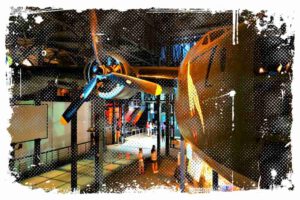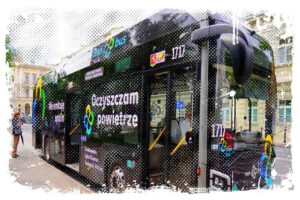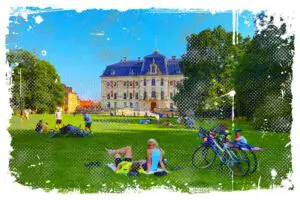When we think of the concept of hell, we often have in mind images from the Bible of a place of punishment where sinners are subjected to pain with no end in sight. But when you visit the former German concentration and extermination camp at Auschwitz-Birkenau, you get the sense that hell existed there for many years.

Hunger, medical tests, fear, forced labor, disease, killings, gas chambers and Zyklon B were all experienced by the Poles, Jews, Roma and other nationalities who were brought there.
A visit to the Auschwitz Memorial and State Museum is not an ordinary trip. A visit to the camp brings back memories of what happened during the genocide and the Holocaust, and the horrors that took place here are enough to make your skin crawl. Such a visit will also make people think about what happened.
You may also be interested in reading the article about other interesting places in Poland: Exploring Poland’s Cultural Riches: A Guide to UNESCO Cities
↳ PRO TIP: Do you like traveling? Then before you buy any ticket or book an attraction, check if it's available in this worldwide Viator Database. You may save a lot of money and time. No need to thank me :)
German Nazi Concentration and Extermination Camp Auschwitz-Birkenau in Oswiecim
The concept for the concentration camp was formed in late 1939, and the Germans chose Auschwitz – formerly known as Oswiecim – because of its proximity to a railroad and the pre-existing barracks there. The first large transport of people arrived on June 14, 1940, and it was officially opened. That day, a total of 728 Poles and some Polish Jews were transported by rail from a Tarnów prison. The camp was originally set up to hold political prisoners. It was intended for the Polish elite and opponents of the Nazi regime.
In 1942, the Auschwitz II (Birkenau) camp was established in the village of Brzezinka (also known as Birkenau), just three kilometers from Oświęcim. It was established as part of the Nazi mission to exterminate the Jews living in the occupied territories and was the largest part of the complex. It soon grew to be the largest Nazi German extermination camp. Most of the victims of Auschwitz perished in this camp.
In addition to the two major camps, more than forty smaller camps (Auschwitz III) were built between 1942 and 1944 for the purpose of using prisoners as slave labor. These camps were mainly built near German factories, farms, and ranches.
The camp was liberated on January 27, 1945. The Auschwitz I and II camps were eventually transformed into the Auschwitz-Birkenau State Museum in Oswiecim. In recognition of its importance to humanity, the area of the former camp now occupied by the museum was inscribed on the UNESCO World Heritage List in 1979. It is the only such site on the list to represent other genocide sites.
How Many People Died in the Auschwitz-Birkenau Camp?
It is difficult to calculate the exact number of people who were sent to Auschwitz, since the Germans started erasing all evidence of their crimes in August of ’44, by destroying documentation and burning records. Nevertheless, there is a consensus that the number of people deported to Auschwitz was at least 1.3 million, of which they were:
- 1,100,000 Jews,
- 140,000-150,000 Poles,
- 23,000 Roma,
- 15,000 Soviet prisoners of war,
- 25,000 Orisoners of other nationalities.
Approximately 1.1 million people perished in Auschwitz, with the overwhelming majority of them being Jewish. Most of these people were murdered soon after entering the camp. They were taken straight to the gas chambers. When the camp was liberated, there were only around 7,000 people left.
What is it like to visit Auschwitz-Birkenau Camp in Oswiecim?
If you don’t come with an organized group, you have several tour options to choose from. The most popular of these are the individual tour without an educator and the general tour.
Individual Tour Without Guide
During the months of April through October, the only times you can visit the camp without a guide is before the busiest hours and after them. This rule was established in 2018 due to the high volume of people coming to the camp. Entrance is free, and it is recommended that you book a visit via the museum’s website.
Tours with a Guide
A standard tour accompanied by a knowledgeable guide can last approximately 3.5 hours. This is the optimal choice if you would like to gain an understanding of the history of the concentration camp and the tragic events that occurred there. To ensure that nothing is overlooked, visitors are provided with headphones before entering the grounds of Auschwitz I with a guide.
Visiting Auschwitz I Concentration Camp – Experience
Just like the prisoners, we cross the gate with the inscription „Arbeit macht frei” (Labour Makes You Free) placed above it. It is a symbol of the camp and the suffering of millions of people. There are the brick camp barracks in front of us, which now house thematic exhibitions.
We learn about the lives of the prisoners from the moment they walked through the gate until they were cremated. We get a glimpse of the people who ended up in this hell through the photographs hanging on the walls. They were robbed of everything, even their names. Stacks of suitcases, prostheses, cosmetics and cut hair make a big impression.
We stop briefly between barracks 10 and 11, where flowers have been laid and candles lit to commemorate the prisoners who were executed there. The entrance to the gas chamber and crematorium is the last stop on our tour of Auschwitz I. On the walls you can still see the scratches of those who tried in vain to escape from the Zyklon B. Our guide explains that the suffering these people endured could last anywhere from a few seconds to as long as 20 minutes.
Visiting the Auschwitz II (Birkenau) Extermination Camp
We take a free bus that runs between the camps to go from Auschwitz I to Auschwitz II (Birkenau). We get off next to the guardhouse and main gate of Auschwitz II, where the Nazis brought people from all over Europe, mostly Jews. Many transports went straight to the gas chambers, and if necessary, the Nazis selected those suitable for forced labor or medical experiments. Those who made it through were given a number and then the Nazis would tattoo them.
Compared to the original camp, Auschwitz II has a different appearance. There is a large grassy area lined with barracks and chimneys. The remains of the gas chambers and crematoria destroyed by the Germans at the end of the war are located where the tracks end. In between there is the International Monument to the Victims of Auschwitz and 23 panels, each of them inscribed with the same sentence, although in a different language:
„For ever let this place be a cry of despair and a warning to humanity, where the Nazis murdered about one and a half million men, women, and children, mainly Jews from various countries of Europe. Auschwitz-Birkenau 1940 – 1945”
The tour ends in one of the barracks, where we try again to imagine the conditions in which the prisoners must have lived. The bunk beds on three levels look more like a chicken coop than a place where people could stay.
Why To Visit The Former Nazi Concentration and Extermination Camp
A visit to Auschwitz is a truly heartbreaking experience, and yet it is something that everyone should attempt to do at some point in their lives. The buildings, photographs, displays, and artifacts there are a reminder of the cruel history of the place, and will stay with you long after you leave.
As you walk through the camp, it is almost as if you are traversing a well-oiled machine that was designed to process people as if they were animals. They were herded into wagons and then divided up. Those who were ill, elderly, or too young to work went straight to the gas chambers. Before that, they were stripped of all their possessions, just like the rest of the prisoners.
Those who managed to survive the segregation were shaved and marked, then placed in a special section They were assigned various tasks, which they performed until they became exhausted or ill. With the food they were given, they had a maximum of three months to survive before they were taken to the gas chamber.
Exploring Auschwitz-Birkenau can be seen as a history lesson, but it’s worth looking at it from a broader perspective. It’s important to consider what was behind the rise of fascism, how the wave of aggression and brutality was created, and to make comparisons with later years and the present.
It’s discouraging to realize that as humans, we don’t seem to take our mistakes to heart. Even since the end of World War II, conflicts have continued. Tyrants remain determined to maintain absolute power – and are unwilling to accept anything less. This has led some to kill their own people, such as the Khmer Rouge, who were responsible for the deaths of two million Cambodians during their four-year reign. Others will fight to gain control of someone else’s natural resources.
At the moment we’re seeing a return of bigotry, nationalistic sentiments and xenophobia in Europe and Poland. We can only hope that humanity will come to its senses, because who knows if we’ll be able to survive another world war.
Practical information
The Auschwitz-Birkenau State Museum is one of Poland’s three most visited museums, with over 2,100,000 visitors per year. There is a lot of interest in this camp and those who arrive without a reservation have to wait in long lines. I recommend booking your ticket on the museum’s website ahead of time and arriving half an hour before the scheduled time to pick up your ticket (there are also lines here).
Inside Auschwitz, backpacks or bags larger than 20 cm, 30 cm, or 10 cm are not permitted. If you arrive with such a bag, you will have to use the paid storage room.
Note: It is not recommended for children under 14 to visit the Museum.
Tickets to the Auschwitz-Birkenau Memorial and State Museum in Auschwitz – Price List. February 2023 update.
Access to Auschwitz is free, but you can only do so early in the morning or late in the afternoon before it closes from April to October.
During other hours, you can:
- Take a general tour in polish, either individually or with a group, and have 3.5 hours to walk. A regular ticket costs 75 zloty, but if you’re a student or a pupil up to 26 years of age with a valid ID, you can get a discounted ticket for 65 zloty.
- If you are looking for a personalized tour in a foreign language, you can choose our 3.5 hour general tour. The price of a regular ticket is 85 zloty, but students and pupils up to 26 years of age with a valid ID card can get a discounted ticket for 75 zloty.
- For both polish and foreign languages, there are also studio tours of up to 6 hours. The regular ticket costs 125 PLN, but students and pupils up to 26 years of age with a valid ID card can get a discounted ticket for 105 PLN.
Free and paid entry cards can be reserved at http://www.auschwitz.org.
For those seeking a personalized tour experience, museum offers the option of booking an individual guide. Their guides are able to conduct the tour in a variety of languages, including English, Croatian, Czech, French, Hebrew, Spanish, Japanese, Dutch, German, Norwegian, Polish, Russian, Serbian, Slovak, Swedish, and Italian.
Reserving a guide is easy. You can book one online with 5 days notice or email the museum with 2 to 5 days notice.
Open Hours of the Auschwitz-Birkenau Museum in Oświęcim
The Museum is open all year round with the exception of January 1, December 25 and on the first day of Easter. Opening hours vary from month to month.
You can plan your visit during the following times:
- April, May, and September: 7:30am – 6:00pm
- June, July, and August: 7:30am – 7:00pm
- March and October: 7:30am – 5:00pm
- February: 7:30am – 4:00pm
- January and November: 7:30am – 3:00pm
- December: 7:30am – 2:00pm
The above hours are for entry to the Museum. You can stay inside one and a half hours after the last hour of the start of the tour (e.g. in February it is 5:30 pm, in June it is 8:30 pm)
How To Get to the Auschwitz-Birkenau Memorial and State Museum in Oswiecim
You will find it easy to reach Auschwitz as it is well connected to both Katowice and Krakow. Public transportation is available and makes getting to Auschwitz easy and convenient. The journey from Katowice takes about 50 minutes, while from Krakow it takes 1.5 hours. The Auschwitz train station is only 1.6 kilometers from the camp and can be reached by a 21-minute walk. This makes Auschwitz easily accessible to all visitors.
Bibliography
- https://www.auschwitz.org/en/
- https://en.wikipedia.org/wiki/Auschwitz-Birkenau_State_Museum
- https://europeanmemories.net/partners/auschwitz-birkenau-state-museum/



